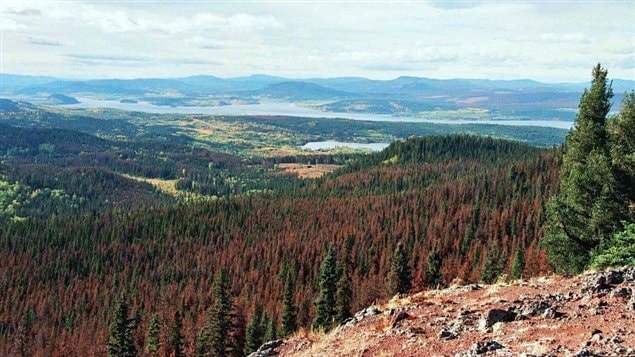
The Canadian federal government, through the Natural Sciences and Engineering Research Council of Canada (NSERC) has injected another three million dollars into the fight against the mountain pine beetle.
The tiny insect has caused massive forest destruction of millions of hectares of forests in west coast British Columbia, before spreading eastward into Alberta and now Saskatchewan, and potentially the entire boreal forest of Canada.
Janice Cooke PhD is a researcher in the Department of Biological Sciences at the University of Alberta. The money will help fund her Turning Risk Into Action Network (TRIA-Net), an interdisciplinary team of scientists and forest practitioners from government, not-for-profit, and industry organizations addressing the rapid spread of this devastating pest. –
The mountain pine beetle and the lodgepole pine forests of south- central British Columbia have co-existed in a balance for millennia.

The beetles attack the tree by burrowing into the bark, but the lodgepole pine tree has developed defences by secreting sticky sap that can trap the invader. The beetle in turn secretes pheromones that attract other beetles to the tree, which attempts to fend them off. Healthy trees can usually fend off the attacks from several beetles, so usually only older trees near the end of the life cycle succumb.
This “limited” killing of lodgepole pine for millennia has helped the forests to regenerate.
Cold winter weather in the past had previously kept the beetle populations in check, but with global warming changing the climate since the late 1990’s, beetle population numbers which would have been kept down have instead exploded.

This has meant vast numbers of insects attacking and overwhelming even healthy young lodgepole pine, killing off vast swaths of forest.
The swarms of beetles surviving the warmer winters has also been able to expand into the mountains and in 2006, breech the Rocky Mountain barrier and expand east into Alberta.
In Alberta the lodgepole pine has hybridized with jack pine.
Research has now shown the beetle spread across the hybrid zone and has successfully established itself in genetically pure jack pine,.
The great concern is that these trees have not co-evolved with the beetle like the lodgepole with its defences, and it’s suspected that these forests may be even more vulnerable to beetle infestation.
This has caused great concern because jack pine is a major species in the boreal forest which spreads right across the entire rest of Canada all the way to the Atlantic coast.
“These forests have not been considered part of the mountain pine beetle’s native range. This raises a lot of questions about how easily mountain pine beetle can spread and become established in these new regions, perpetuating the outbreak,” says professor Cooke.
The TRIA collaborative network will use a novel approach that integrates genomics, molecular analysis, population genetics, systematics, ecology, population dynamics and modelling to improve the understanding of how mountain pine beetles interact with their pine hosts and the fungal symbionts that the beetles carry. The fungus is what eventually kills the tree.
The research group will also study how environmental conditions affect these interactions and how the genetics of these organisms may influence mountain pine beetle spread.
So far actions to limit the spread have consisted of cutting down infected trees and burning them and the beetles within, or pre-emptive cutting of trees to prevent spread.
Neither strategy has proven successful, as its impossible to cut down all the trees and the researchers have found the beetles can fly much further than previously thought up to 20 or even 30 kilometers, and if they catch the wind, even further.
The concern is that if the beetles continue to spread, they will change the forest makeup along with the entire boreal ecosystem, and the birds and animal populations and make-up, and in ways we can’t yet fathom.







For reasons beyond our control, and for an undetermined period of time, our comment section is now closed. However, our social networks remain open to your contributions.